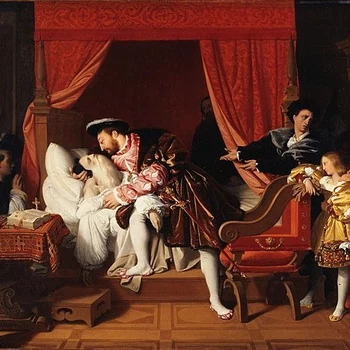Giorgio Vasari's biography of Leonardo da Vinci
Who was Giorgio Vasari?
Giorgio Vasari (1511-1574) was an architect and painter from Florence. He was trained together with members of the famous Medici noble family and from then on carried out their commissions. Among other things, he was responsible for the construction of the Uffizi Gallery in Florence. Originally an administrative building, today it is one of the most famous museums in the world.
Likewise, the transformation of the "Hall of 500" in the Palazzo Vecchio, Florence was among his tasks (1540). The hall is best known for the fact that Leonardo da Vinci is said to have painted the Battle of Anghiari there. At the same time, the younger Michelangelo is said to have painted there the Battle of Cascina. Both paintings are lost today.
Giorgio Vasari was also active as a writer. His main work is a collection of artists' biographies "The Lives of the Best Italian Architects, Painters and Sculptors from Cimabue to Today". Through this work he is considered today as one of the first art historians. Included, among others, is a biography of Leonardo da Vinci. There are two editions of his biographies of artists: a first from 1550 and a second, slightly modified text, from 1568. The edition below follows the translation by Dr. Fritz Schillmann from 1948.
What is the significance of Vasari's biography?
Source for art history
Vasari's biography of Leonardo da Vinci is mainly consulted to prove the authorship of certain works of art, in Leonardo's case, for example, the "Madonna with the Carnation", but also to record traces of lost paintings. Likewise, the designation "Mona Lisa" for the famous painting appears only with him. Later biographers then simply adopted this title.
Vasari's role as a biographer is very ambiguous. On the one hand, art historians are grateful to learn anything at all through him. On the other hand, he makes many false statements, e.g. about Leonardo's age at his death (75 instead of 67). Also, the inaccurate description of the "Anna Selbdritt" indicates that he wrote down hearsay. Many contradictions in Leonardo research then also go back to Vasari's text.
Vasari and the art trade in the Renaissance
In addition, we learn from Vasari's Leonardo biography of a Medusa shield that Leonardo is said to have made and which was traded at great profit by the Duke of Milan, among others, which makes it clear what great importance the art trade had even then in aristocratic circles. For example, only a hundred years later, the English and French kings traded the Leonardo painting "John the Baptist".
If we consider that the Medicis, Vasari's main clients and immediate environment, were originally a banking family, and soberly considered his very flattering artist biographies had only the goal to emphasize the quality of certain artists and to name their works, the suspicion suggests that Vasari was not only concerned with the content of his widely distributed biographies, but also with high sales figures of the books, but it was also commercial interests in the evaluation of the paintings that were in his possession or that of the Medici. It should not be forgotten that the Medici were the greatest patrons of Renaissance painting, owning many Renaissance works themselves. As a noble banking family, they were certainly not a purely charitable organization. Their promotion of art was always an investment in the art market.
Vasari's acquaintance with Michelangelo
His personal acquaintance with the aged Michelangelo, is also significant in terms of Leonardo biography. Certainly he heard one or the other about Leonardo from Michelangelo, since the 22 years younger Michelangelo still experienced him personally. However, Michelangelo and Leonardo had a difficult relationship, which derived from the competition of the arts (see Paragone). Both covered each other with invective to devalue the art of the other.
In light of the above, it would be a mistake to fully believe Vasari's statements. Nevertheless, they can give an impression of how Leonardo must have worked.
Life of Leonardo da Vinci
The original text from 1550/1568 in a translation by Dr. Fritz Schillmann from 1948
Rich and sometimes supernatural gifts we often see spread over individual people by nature with the help of heavenly influences. Sometimes, however, like a tremendous gift, beauty, kindness, and artistic talent unite in a single personality so gloriously that every one of its actions appears happy, all other mortals lag behind it, and it is clearly revealed: its achievement is donated by God, but not acquired by human art. This was recognized in the case of Leonardo da Vinci. His body was adorned with beauty never sufficiently praised, in all his actions he showed the greatest grace, and he possessed such perfect abilities that he solved with ease even the most difficult thing he undertook. Rare strength combined in him with agility, his courage and boldness were sublime and great, and the fame of his name spread so far that he was praised not only by the fellow world, but even more by posterity.
Truly wonderful and godly was Leonardo, the son of Ser Piero da Vinci. He would have achieved great things as a scholar in the sciences if he had been less fickle and changeable. But he undertook many things and very soon abandoned those he had begun. Thus, he made incredible progress in arithmetic in a few months and constantly presented doubts and objections to his master, often leaving him in confusion. He also began to study music and soon decided to learn to play the lute. And since his mind was directed to the highest and full of the most beautiful thoughts, he improvised wonderful songs to this instrument.
Training at Verrocchio
Although he did many things in this way, he did not refrain from drawing and making reliefs, an occupation that suited his sense more than others. His father Piero, seeing this and recognizing the majesty of his mind, one day took a number of his drawings and brought them to his friend Andrea del Verrochio with the urgent request to tell him if Leonardo, if he devoted himself to the art of drawing, could achieve something in it. Andrea was astonished by the boy's extraordinary beginnings and encouraged Piero to let him choose this profession, whereupon the latter sent Leonardo to Andrea's workshop. The boy entered here with great enthusiasm and now practiced not only one profession, but all those that belong to the field of drawing. He had such a happy and wonderful mind that he became an excellent geometer, who not only worked as a sculptor, forming at a very young age some laughing female heads in clay that were reproduced in plaster, and also some children's heads that seemed to be formed by a master's hand, but also made many drawings for ground plans and buildings in the art of building. In spite of his youth, he was the first to propose to make the Arno River into a canal from Florence to Pisa. Likewise, he made drawings for mills, fulling mills and other machines driven by water, and since he chose painting as his true profession, he practiced a lot in drawing from nature. Sometimes he formed models of various figures in earth, laid over them soft rags dipped in plaster, and endeavored with extreme patience to trace them on very fine or already used canvas, executing them admirably in black and white with the point of the brush. On paper he drew so diligently and cleanly that no one has ever equaled him in delicacy. - God had poured out such grace upon this spirit, combined with an extraordinary gift of representation and a clear mind, which was everywhere aided by his ever-reliable memory. He could express his thoughts so clearly in drawings that he was able to defeat any mind, no matter how strong, by his speeches and confuse it by his reasons. Every day he made models and drawings to show how mountains could be removed and drilled through with ease to get from one level to another; how great loads could be lifted and pulled with hoisting beams, reels, and screws; in what way seaports could be cleared out and water brought up from the depths by pumping. Such difficult things his mind conceived without ceasing, and there are a lot of drawings of these thoughts and efforts. Manuscripts with Leonardo's drawings are still numerous, some of them unpublished. The most famous is the so-called Codex Atlanticus in Milan. In addition, he wasted a lot of time drawing orderly braids of strings, in which one could trace the thread from one end to the other, until he described a completely circular figure. A very difficult and beautiful drawing of this kind is engraved in copper, in the center of which one reads the words: LEONARDI VINCI ACADEMIA.
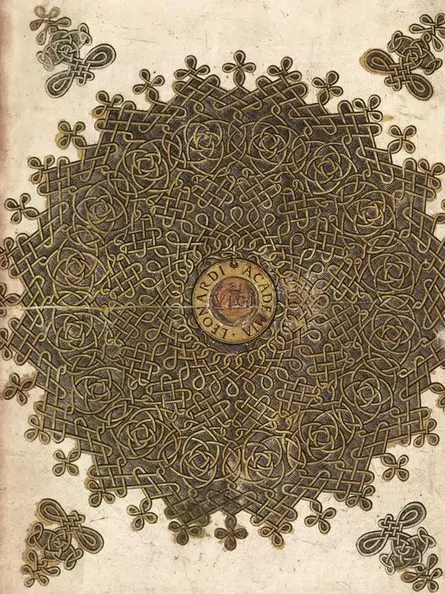
Among these drawings and models was one with which he repeatedly showed the numerous knowledgeable citizens who ruled Florence at the time that he could lift the Temple of San Giovanni and slide the steps underneath without damaging it. He demonstrated all this with so much persuasion that only after he had left did they realize how impossible this undertaking would be.
Leonardo's Character
In conversation, Leonardo was so pleasant that everyone was attracted to him. Although he actually owned almost nothing and worked little, he always kept servants and horses, in which he took great pleasure. Likewise, he treated all other animals with great love and patience. Often, when he came to a place where birds were being sold, he would take them out of their cage with his own hands, pay the price demanded, and then let them fly to give them back their lost freedom. That is why nature was so friendly to him that, whatever he turned his heart and mind to, no one else equaled him in determination, liveliness, goodness, loveliness and grace.
Leonardo began much for the love of art, but almost never finished anything, for it seemed to him that the hand could never reach the perfection in art that his mind had in mind. His ideas were so varied that he also thought about natural processes, tried to learn about the nature of plants, and observed the movement of the sky, the course of the moon and the sun. Therefore, such a heretical attitude formed in his mind that he no longer approached any religion, since he probably appreciated being a philosopher more than a Christian.
Leonardo's painting by Verrocchio
He came, as said, in his childhood to Andrea del Verrochio in the apprenticeship. The latter was working on a panel of the Baptism of Christ, and Leonardo painted in it an angel holding some vestments. Despite his youth, he executed this figure so perfectly that his angel far surpassed Andrea's figures. This was the reason why the master did not want to touch any more colors, full of anger that a child understood more than him.
Then Leonardo was commissioned to draw the Fall of Man in Paradise, a box intended for a door curtain in gold and silk to be woven in Flanders for the King of Portugal. In this box, Leonardo executed in grisaille, with lights in lead white, a meadow that contained an endless number of species of plants and some animals, all completed with so much accuracy and naturalness that one may truly say that no other godly artist in the world could have done it just so. There is also a fig tree, with leaves and branches of the most beautiful foreshortening and loving execution, so that one is amazed at the infinite patience that is manifested here. There is also a palm tree whose fan-shaped crown is shaded and rounded with such great art that only Leonardo's patience could have made it so. This box, by the way, was never woven and it is now in the fortunate collection of the illustrious Ottaviano de'Medici, to whom it was recently given by Leonardo's uncle.
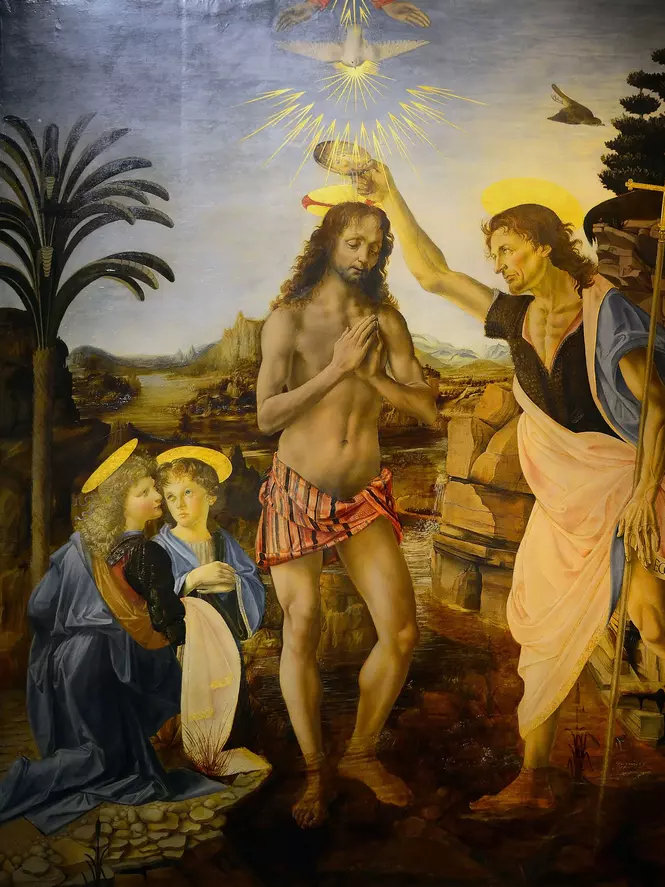
The head of Medusa
The story goes that one day one of his peasants visited Ser Piero da Vinci in his country house, brought him a round shield made by himself from a fig tree of the estate and asked him to have something painted on it in Florence. Piero was happy to do it, because the farmer had a lot of practice in catching birds and fish, and he often used his help in these matters. He had the shield brought to Florence, gave it to Leonardo without saying who it belonged to, so that he could paint something on it. One day he took the shield, saw that it was crooked, badly and clumsily worked, bent it at the fire and finally had a wood turner form a fine and even one from this clumsy work. He then primed it with plaster, prepared it in his own way, and began to think about what he could paint on it in order to frighten the one who confronted him and to produce the same effect as the head of Medusa once did. For this purpose, he brought into his room, which he entered alone, lizards, crickets, snakes, butterflies, grasshoppers, bats and other strange animals of this kind, and created from this strange heap, by various combinations, a hideous and frightening monster. Poisonous breath spouted from its open maw, fire from its eyes, and smoke from its nostrils, while it emerged from a dark, broken rock, so that it appeared truly monstrous and terrible. In his excessive zeal for the work, he had not even noticed the unbearable stench that the now deceased animals were spreading in the room. When the work was finished, which neither the farmer nor his father had bothered with, Leonardo asked the latter to have the shield picked up occasionally; he, for his part, was finished with it. Ser Piero therefore went to the son's home one morning and knocked on the door. Leonardo opened and asked him to wait a little. He hurried back into the room, placed the shield on the easel in right light, let in only a dull glow through the window, and called his father to inspect the work. At first Ser Piero did not think of such a thing, and since he did not think he was looking at the shield, but at a painted beast, he involuntarily backed away. Leonardo, however, held him and said: "The work is useful for the purpose for which it was made. Take it and carry it away; that is the effect expected from a work of art." To the father the thing seemed more than marvelous, he praised the whimsical idea, bought, without saying anything, another shield, on which was painted a heart pierced by an arrow, and gave it to the peasant, who felt indebted to him for it all his life. Leonardo's shield, on the other hand, he sold for a hundred ducats to merchants in Florence, through whom it soon came into the possession of the Duke of Milan, who paid three hundred ducats for it.
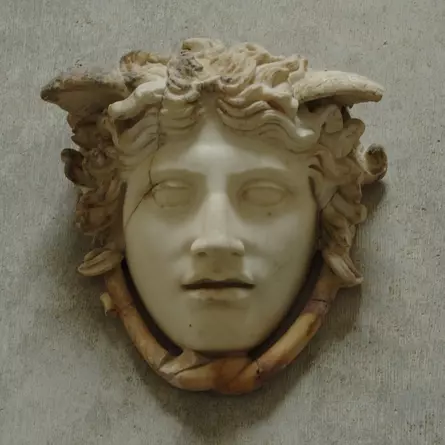
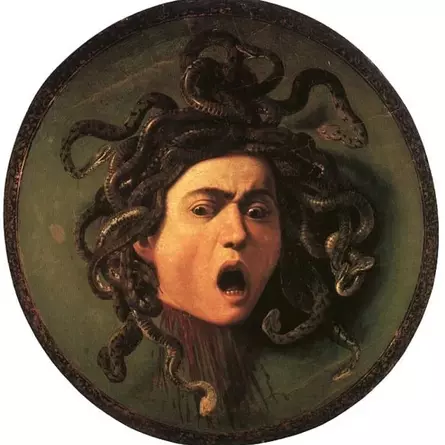
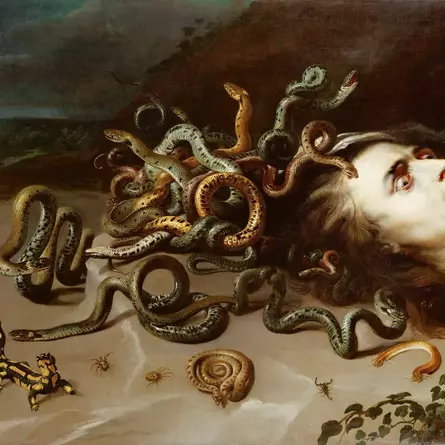
Madonna painting
Leonardo then painted a quite outstanding Madonna painting, which later became the property of Pope Clement VII. Among other things, this painting contained a glass vase filled with water and flowers in it, a marvel of fidelity, the dew pearls on the petals were so naturally rendered that they appeared more real than in reality.
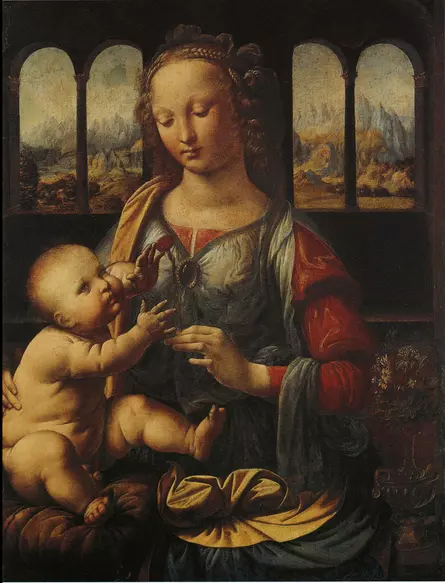
Drawing of a Neptune
For his close friend, Antonio Segni, he drew on a folio sheet a Neptune that seemed to be alive, so carefully was it executed. One saw the churning sea, Neptune's chariot pulled by sea horses, surrounded by water spirits, monsters and winds; the pots of some sea gods are wonderfully drawn. Antomo Segni's son, Fabio, made this drawing a gift to the knife Giovanni Gaddi, with the following epigram:
Virgil and Homer, they both represented Neptune,
How he guides the sea horses through the raging waves.
But what the poets only saw in their minds, da Vinci saw
With his own eyes; he has truly surpassed them.
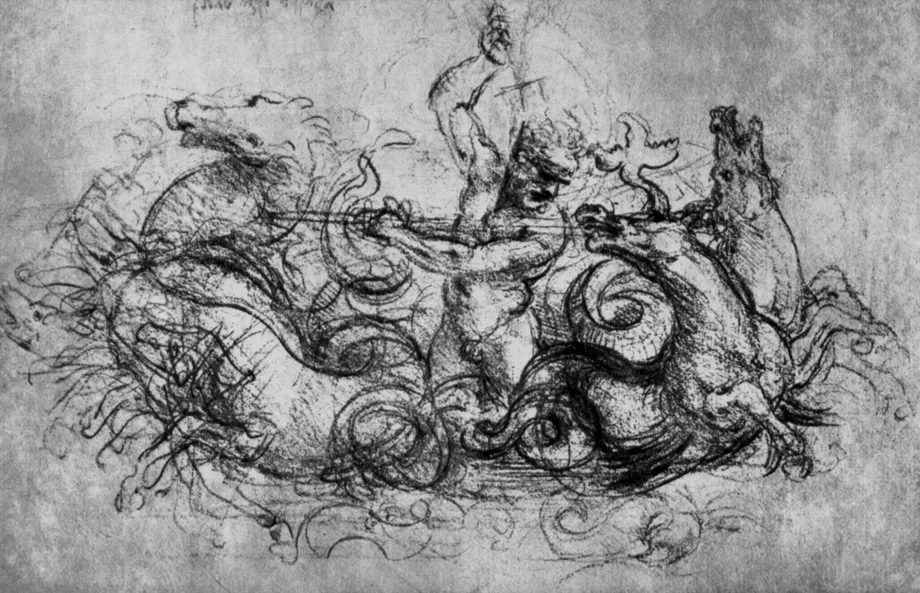
Oil painting of the head of Medusa
Leonardo also had the fantastic idea of painting in oil the head of Medusa with a coiffure of intertwined serpents, the strangest and most whimsical invention imaginable. But since the work required time, he left it unfinished, like so many other things. It belongs to the magnificent treasures in the palace of Duke Cosimo,
John the Baptist
together with the half figure of an angel, whose arm is raised and drawn shortened from the shoulder to the elbow, so that it comes forward, while the hand of the other arm is on the chest.
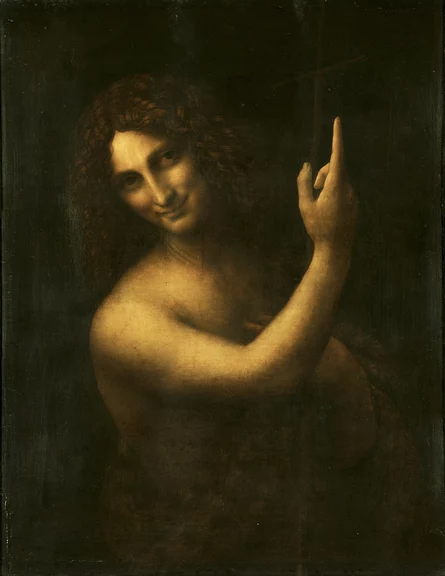
Leonardo's painting technique of the sfumato
It is marvelous how this genius, who strove to make the objects he created stand out vividly, went about with the dark shadows in such a way as to find out the keynote of the still darker ones, as he searched for a black that was blacker than the rest and would be suitable for shading them, and through which the lights would appear even more brilliant. At last he discovered those quite dark inks in which there is no light at all, better suited to imitate the night than the faintest glow of daylight. But all this was done in order to give the objects more roundness and to lead the art to the limit and perfection.
Leonardo's character drawings
It was a special pleasure for him when he met people with unusual facial features, beards or hair ornaments. He could have followed such people all day long, and their figure became so imprinted on his mind that he drew them at home as if they were standing in front of him. In this way he had executed many male and female heads.
I myself possess in my often quoted collection some pen and ink drawings by his hand. The portrait of Amerigo Vespuci, a magnificent old man's head, was also of this kind.
A charcoal drawing and also the portrait of the Gypsy chief Scaramuccia, later then in the possession of Messer Donato Valdambrini, who received it from the estate of Gambullari.
A panel with the Adoration of the Magi was started by him; it contains much beauty, especially in heads, but remained unfinished, like his other works.
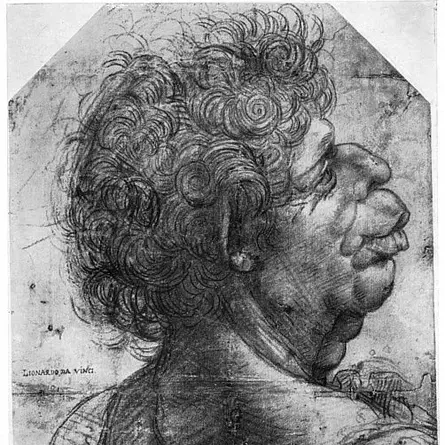
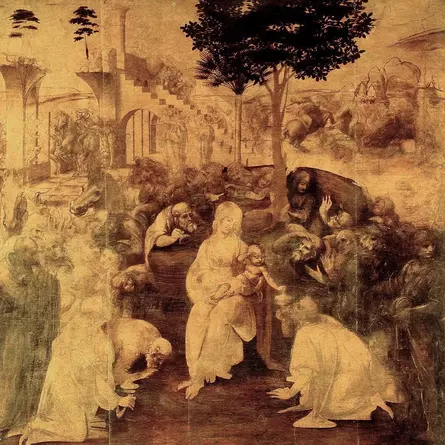
Leonardo as a musician
In 1494 Giovan Galeazzo, Duke of Milan, had died, and Lodovico Sforza was chosen as his successor. The latter found great pleasure in playing the lute, and Leonardo was therefore honorably summoned. He took with him an instrument that he himself had made almost entirely of silver in the shape of a horse's head, a strange and new shape, calculated to give the sound more strength and melodiousness. Thus he surpassed all the musicians who had come to Milan to play. Moreover, in his time he was the best improviser in rhyme. The Duke, enraptured by Leonardo's wonderful gifts, fell in love with his talents to such an extent that it was almost unbelievable.
Birth of Christ
He asked him to paint an altarpiece, a Nativity, which was sent as a gift from Lodovico to the Emperor.
The Last Supper
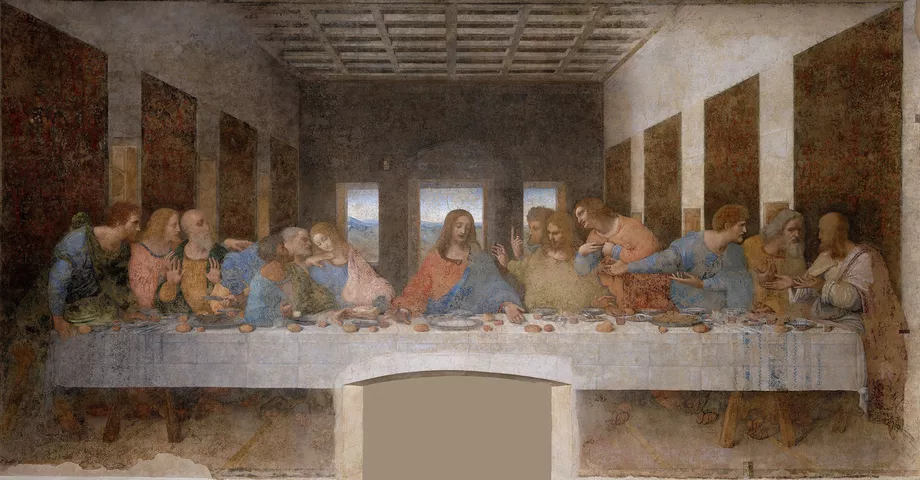
For the Dominican monks in Santa Maria delle Grazie in Milan he created a Last Supper of rare and marvelous excellence. He gave so much majesty and beauty to the heads of the apostles that he left the head of the Savior unfinished, convinced that he could not give it the heavenly divinity required for an image of Christ. The work remained as if it were finished and has always been praised by Milanese and foreigners alike. Leonardo had succeeded in expressing in the best way the suspicion that gripped the hearts of the apostles, who wanted to know who had betrayed their master. From the faces of all speaks love, fear and anger, but also the pain that they do not understand the soul of Christ, and this is just as wonderful as the defiance, hatred and betrayal that one recognizes in Judas, moreover, the slightest details of the whole work are worked with incredible care, even the fabric of the tablecloth is reproduced as one could not see it better in the finest linen.
It is said that the prior of the monastery very impetuously urged Leonardo to complete the work. It seemed strange to him to see the artist sometimes lost in contemplation for half a day. He would have preferred it if he, like workers who hoe the garden, had never laid down his brush. But this was not enough for him. He also complained to the duke and pressed him until the latter felt compelled to have Leonardo summoned and most kindly spurred him on to work, assuring him worthily that he was only doing so at the prior's importunity. Leonardo knew the clear mind and tact of the prince, so he decided to talk to him at length about the matter, which he would never have done with the prior. He spoke at length about art and made him understand that sublime minds sometimes create the most when they work the least, that is, when they invent and form perfect ideas, which the mind then grasps and the hands express and shape. Two heads, he added, were still missing: that of the Redeemer, for whom he did not want to search on earth and who, as he believed, could never come to his imagination in that beauty and heavenly grace which corresponded to the incarnate Godhead; the other, about which he was thinking, was that of Judas. It seemed impossible to him to find suitable features for that disciple whose defiant spirit, after so many benefits received, would have been capable of the decision to betray his Master, the Creator of the world. For this, however, he would seek, and if he found no other, he would still have the troublesome and meddlesome prior. This made the duke laugh very much, and he agreed with Leonardo a thousand times. The poor prior, however, being in confusion, occupied himself henceforth with his gardening and left the artist in peace; the latter finished the head of Judas so admirably that it is the true image of treachery and inhumanity; the head of Christ, on the other hand, remained unfinished.
The glory of this painting, the composition as well as the diligent execution aroused in the King of France the desire to have it brought into his kingdom. He searched in every way for builders who could bind it tightly enough with wooden beams and iron so that it could be taken away undamaged, he paid no attention to the possible costs, so great was his desire for it. However, because it was painted on the wall, his majesty finally lost the desire for it, and it remained in Milan.
Portrait of the Duke of Milan and Beatrice d'Este
While he was still working on the Last Supper, at the front of the same refectory where there is a Passion of Christ in the old style, he portrayed Duke Ludovico and his firstborn son Massmiliano, and to the other side the Duchess Beatrice with her younger son Francesco: Wonderful portraits.
The equestrian statue for the Duke of Milan
While he was working on this work, Leonardo proposed to the Duke to make a horse in bronze of astonishing size and to have the late Duke represented on it in memory.The monument was to represent the Duke's father, Marquis Francesco Sforza.He began and completed the model, but in such size that it could never be executed. And as often happens. And as envy often causes people to judge maliciously, there were those who thought that Leonardo had begun it like other of his works so that it would not be completed. His greatness was the cause of incredible difficulties when it was to be cast in one piece, and one could well believe that the outcome had given some people that thought, because very many of his works did not reach the end. But probably his sublime, splendid spirit was hindered by too great striving, so that his striving to achieve excellence over excellence and perfection over perfection was to blame, and, as Petrarch says, "desire inhibited the work". Whoever looked at the model of that monument, executed in clay by Leonardo, confessed to never having seen anything more beautiful and proud. It survived until the French came to Milan with their King Louis and destroyed it. A small, very perfect wax model of the same work has also been lost, along with a book on the anatomy of horses that Leonardo had worked on for his own study.
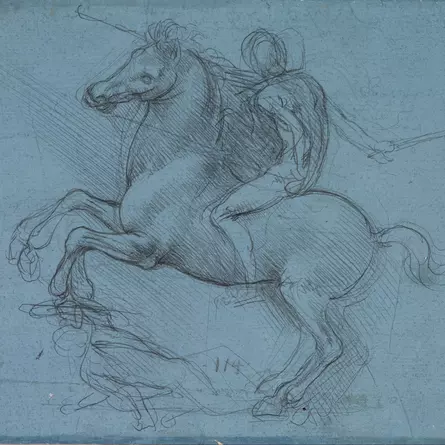
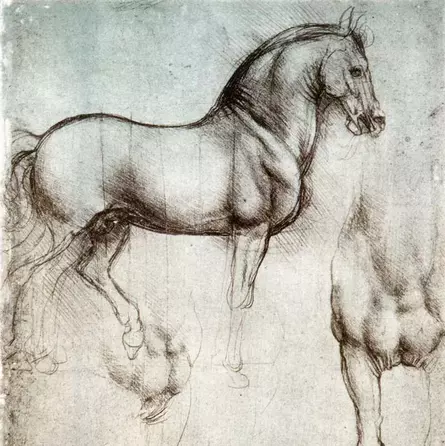
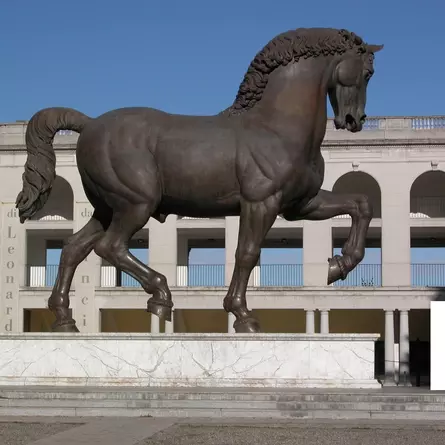
Anatomical studies
He studied human anatomy with even greater care. A study in which he and Marcantonio della Torre supported each other. This Marcantonio, an excellent philosopher who lectured and wrote about it in Pavia at that time, was one of the first, as I heard, who began to explain the medical questions with the teachings of Galenus and brought light to the anatomy, which until then remained in the densest darkness of ignorance. In this he used the spirit, the work and the hand of Leonardo. The latter filled a whole book with red chalk and pen drawings of human bodies, some of which he dissected himself, drawing all the bones, to which he then connected in turn all the tendons and covered them with muscles, first those adhering to the bone, then those holding everything together, and finally those moving everything. and to each sheet he wrote explanations in bad handwriting, which is written upside down with the left hand and which no one who has no practice understands, because it is only read in the mirror. A large part of these anatomical writings of the human body is in the possession of Mr. Francesco da Melzi, a Milanese nobleman; in Leonardo's time he was a child of rare beauty and very dear to him; now he is a handsome, amiable old man; he kept these sheets like dear relics, together with Leonardo's portrait of blessed memory. But whoever reads those writings, it seems unbelievable that this divine spirit could speak so well at the same time about art and about muscles, nerves, veins and everything else with such expertise.
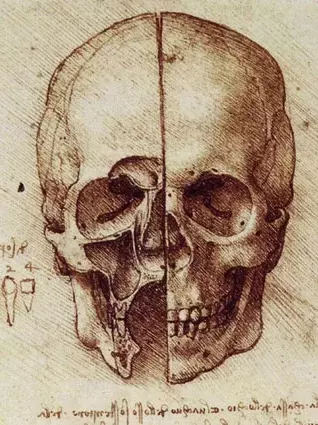
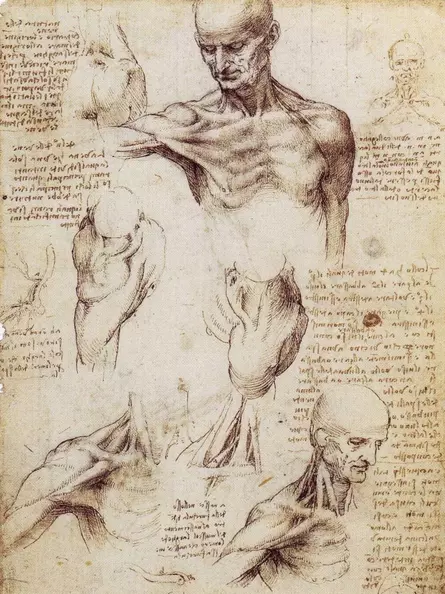
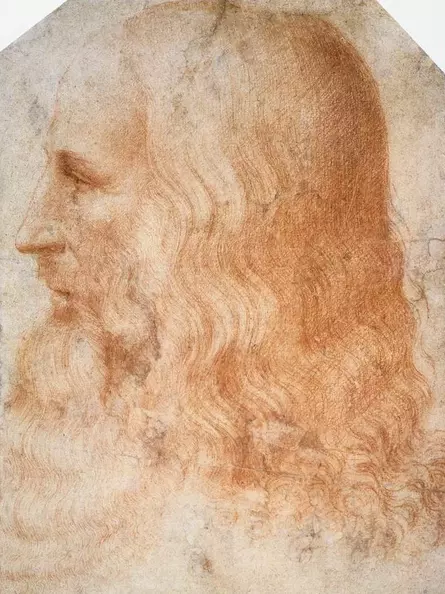
Book of painting
Some other writings of Leonardo, again written with the left hand upside down, are in the possession of a Milanese painter; they deal with painting, draftsmanship and colors. Some time ago, when the latter visited me in Florence, he intended to have the aforementioned book printed; he took it to Rome to publish it there; I do not know what became of it then.
Leonardo's mechanical lion
At that time the King of France came to Milan, and at his request to do some miraculous thing, he created a lion that could walk a few steps and now and then opened its chest, which was full of lilies.
Salai
During his stay in Milan, Leonardo took a young man from that city, Salai, as his pupil. Leonardo took great pleasure in his grace and beauty, especially in his curly hair. He taught him many things in art, and some paintings attributed to Salai in Milan are reworked by Leonardo.
The Virgin and Child with Saint Anne and Saint John the Baptist
Leonardo returned to Florence. There he learned that the Servite friars had entrusted Filippino with the painting for the main altar of the Nunziata, and he said that he would also like to take on such a work. When Filippino heard this, this kind man withdrew from the matter, and the monks entrusted the picture to Leonardo. They took him into their house, gave him a living for himself and all his dependents, which he let happen for a long time without starting anything. Finally, however, he made a box on which the Madonna, St. Anne and the Christ Child were so beautifully depicted that not only all artists, but everyone who looked at them felt obliged to admire them. For two days, men and women, young and old, went on pilgrimage to the room, as if to a brilliant feast, to see Leonardo's marvelous work, which astonished everyone.
For in the face of the Madonna was seen all that simplicity and sweetness which can give grace to the Mother of God; for he wished to represent in her the modesty and humility of the Virgin, who joyfully observes the beauty of the Son; she holds him tenderly on her lap, her eyes demurely cast down, and looks after St. John, who is a little child playing with a little lamb, and St. Anne smiles, filled with joy that her earthly sex has become a heavenly one; loud reflections, according to the mind and spirit of Leonardo. This box later came to France, as will be told below.
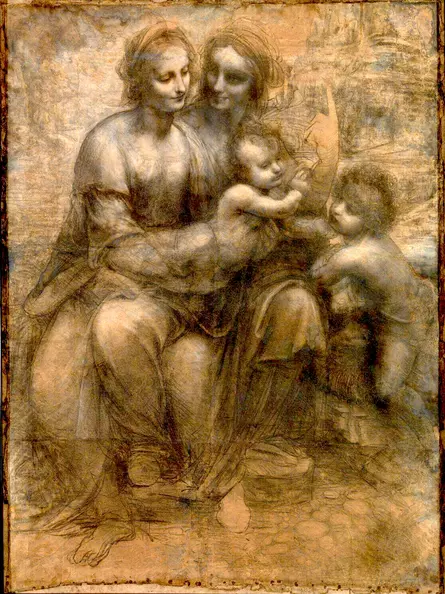
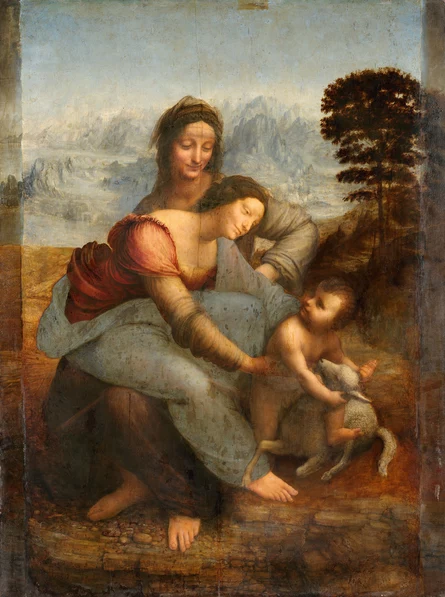
Ginevra de' Benci
Leonardo portrayed the Ginevra d'Amerigo Benci, a very beautiful work
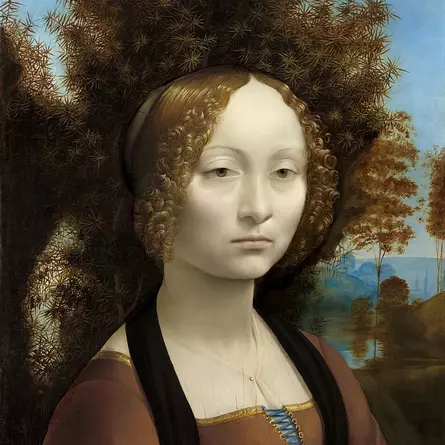
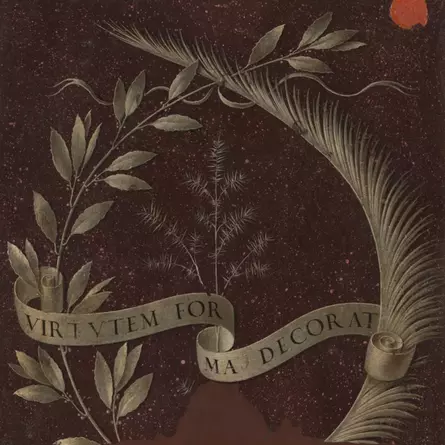
The Virgin and Child with Saint Anne
Then he returned their order to the monks, who now once again entrusted the work to Filippino, who, however, surprised by death, could not complete it.
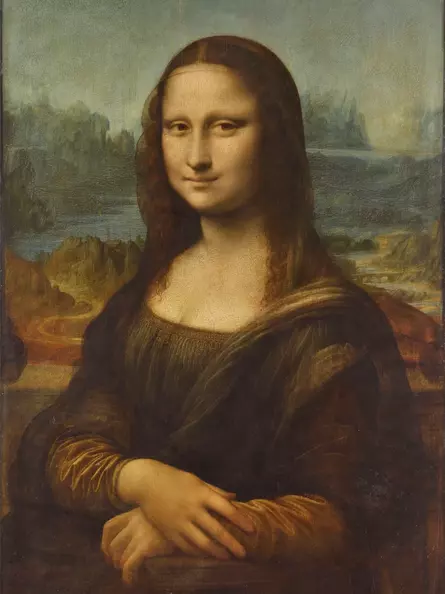
Mona Lisa
Leonardo also began to paint the portrait of the Mona Lisa, his wife, for Francesco del Giocondo. He spent four years of effort on it, then left it unfinished, and it is now in Fontainebleau in the possession of King Francis of France. Anyone who wanted to see how far it is possible for art to imitate nature could see it in this beautiful head. All the small details were depicted in the finest way, the eyes had luster and moisture, as we see it in life, all around one noticed the reddish-blue circles and the veining, which can only be executed with the greatest delicacy. On the brows, where they are fullest, where they are sparest, one saw them emerging from the pores of the skin and arching, as naturally as can be thought. On the nose, the fine openings were rosy and delicately reproduced in the most faithful manner. The mouth, where the lips close and the red unites with the color of the face, had a perfection that it did not appear as painted, but really like flesh and blood. If you looked carefully at the throat pit, you thought you could see the beating of the pulses. In short, one can say that this painting was executed in a way that made every exquisite artist and everyone who saw it tremble. Mona Lisa was very beautiful, and Leonardo still needed the caution that, while he was painting, there must always be someone present who sang, played and joked, so that she would remain cheerful and not acquire a sad appearance, as is often the case when one sits to have his portrait painted. Over this face, on the other hand, floats a smile so sweet that it seemed to be of heavenly rather than human hand; and it was considered admirable because it was completely equal to life.
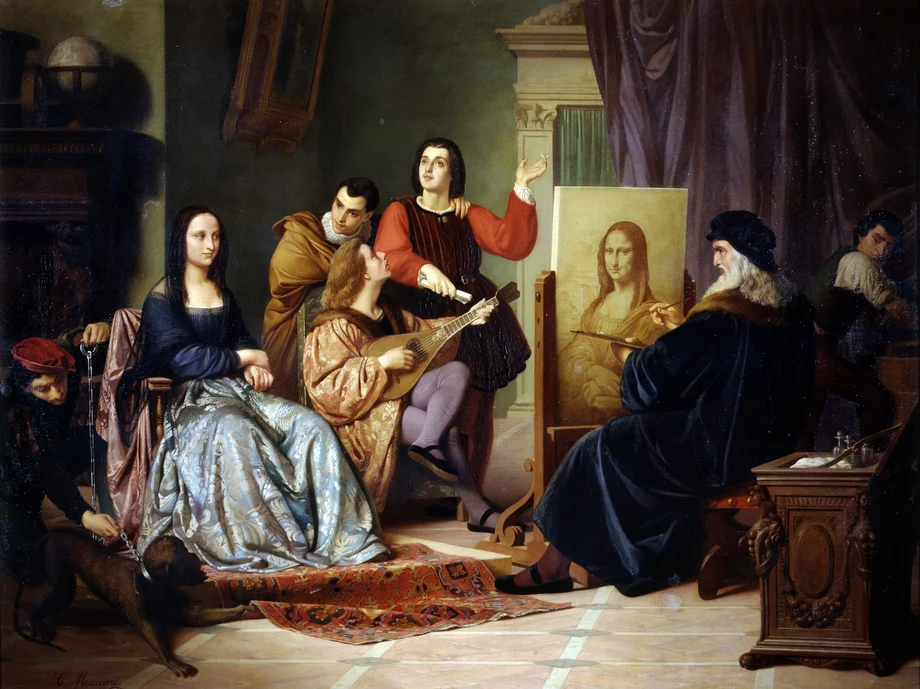
Battle of Anghiari
Through the magnificent works of this divine master, his fame had grown to such an extent that everyone who enjoyed art, indeed all of Florence, yearned for him to leave something there in his memory. There was talk of entrusting him with an important work, so that the spirit and grace that all his works displayed would be an ornament to the city. The Gonfalonieri and the first citizens were negotiating among themselves, since at that time the great council hall had been newly built. It had been finished with great speed and it was now decided by public decree that Leonardo should paint a beautiful picture there. Piero Soderini, then Gonfaloniere of Justice, gave him the work. To carry it out, Leonardo began in Santa Maria Novella, in the hall of the Pope, a cardboard in which he depicted the story of Niccolò Piccinino, field captain of Duke Filippo of Milan. In it he drew a troop of horsemen fighting for a flag, and this work was recognized as masterly because of the admirable deliberation with which Leonardo arranged this stormy scene. Rage, anger and vindictiveness are recognizable in the people as well as the horses. Two of these animals have their forefeet interlocked and are striking at each other with their teeth, furious as the horsemen fighting for the flag. One of the soldiers has grasped the end of the standard with both hands, drives the horse to flee, throws back its body with its powerful shoulders, clutches the shaft of the flag, and thus seeks to wrest it violently from the hands of four warriors who are defending it. Each holds it with one hand, in the other they swing their swords to cut off the shaft, while an old warrior with a red beret has also seized the shaft with one hand. With the other, he raises a crooked saber in the air and, screaming with rage, leads the strike to cut off the hands of the soldiers, who, snarling, try to defend their flag in a fierce position. In addition, two other warriors are drawn foreshortened on the ground between the horses' feet: one is lying on the ground, the other has thrown himself over him, raises his arm high up and puts the dagger to his throat with tremendous force. The other, on the other hand, defends himself with arms and legs to escape death. It can hardly be said how beautifully Leonardo has drawn the various clothing of the soldiers, the helmet ornaments and other ornaments, and what mastery he has shown in the outlines and design of the horses, because better than any other master he knew how to give these animals wildness, proper muscle play and graceful beauty. To execute his cartoon, Leonardo had an immensely artistic framework made, which rose when it was pulled together and lowered when it was pulled apart. Since he wanted to paint the picture in oil on the wall, he made such a thick mixture to glue the wall with that, that in the further course of painting in this room it began to sag in such a way that he gave up the work after a short time, because he realized that it would perish.
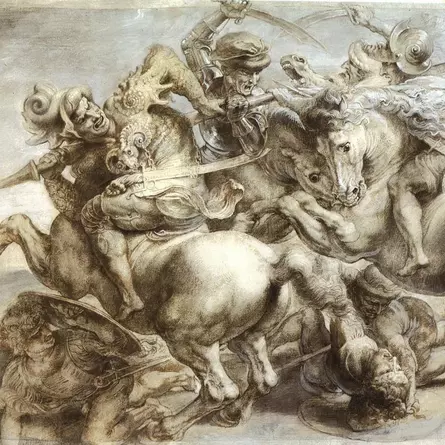
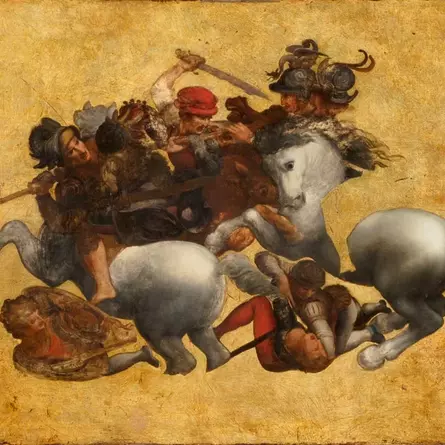
Leonardo's attitude to money
Leonardo had a high sense and was generous in everything he did. It is said that he once went to the bank to collect the monthly commission paid to him by Pietro Soderini. When the cashier wanted to give him some rolls of copper coins, he returned them and said he was not a penny painter. Another time, when he heard that Soderini suspected him of fraud, he collected money from friends and brought the money to Soderini, but he did not accept it.
Leonardo's creative follies
Leonardo went to Rome with Giuliano de' Medici at the time of the election of Pope Leo, who was much occupied with philosophy and even more with alchemy. There he made a dough of wax and, when it was liquid, formed from it very delicate animals, which he filled with air; if he blew into it, they flew, if the air was out, they fell to earth. A strange lizard, which the vintner of Belvedere found, he made wings from the flayed skin of other lizards, which he filled with mercury, so that they moved and trembled when it ran. Then he made her eyes, beard, and horns, tamed her, put her in a box, and used it to scare all his friends into flight. Often he had the intestines of a mutton cleaned out so finely that it could have been held in the hollow of his hand. These he carried into a large room, brought into an adjoining room a few forged bellows, fastened the intestines to them and blew them up until they took over the whole room and one had to flee into a corner. Thus he showed how they gradually became transparent and filled with air, and while they, at first confined to a small space, spread more and more throughout the room, he likened them to genius. He did innumerable such follies, occupied himself with mirrors and tried in the strangest way to find oils for painting and varnishes to obtain the finished works.
Madonna with child
For the head of the papal chancellery, Messer Baldassare Turini of Pescia, he painted with infinite delicacy and art a small panel, a Madonna with Child. This painting is in very bad condition today, perhaps because the panel was not well dressed, but perhaps also because Leonardo experimented forever with his primers and colors.
Image of a boy
On another panel he painted the image of a boy, a wonderfully graceful work. These two paintings are now in the possession of Messer Giulio Turini in Pescia. It was said that when he was commissioned by the Pope to produce a work, he immediately began distilling oils and herbs into a varnish; when Pope Leo heard this, he exclaimed, "O woe! this one will accomplish nothing, since he thinks of the end before the work is begun."
Leonardo and Michelangelo
There was great dislike between Leonardo and Michelangelo, and the competition between the two was to blame for Michelangelo leaving Florence, with Duke Giuliano excusing him, since he had been called by the Pope for the facade of San Lorenzo. When Leonardo heard this, he also left and went to France, where the king owned several works of his and was very fond of him.
The commissioning of Anna Selbdritt by the French king
The king wanted Leonardo to paint the box of St. Anne. The latter, as usual, stalled him for a long time with words.
Leonardo's life confession and death
Finally, having grown old, he lay ill for many months, and when death approached him, he wanted to be instructed with all diligence in the Catholic rite and the correct doctrine of the holy Christian religion. He confessed repentantly with many tears, [talking about Catholic matters of faith and finding himself back on the right path, he converted back to the Christian faith with many tears. He then confessed and repented,1550] and although he could no longer stand on his feet, he nevertheless, supported by the arms of his friends and servants, had the holy sacrament administered to him outside the bed. The king, who visited him often and lovingly, came to see him soon after. Leonardo reverently raised himself to sit up in bed, described to him his evil with all the circumstances, and lamented that he had erred against God and man, since he had done nothing in art as his duty should have been. This effort called forth a stronger fit, which was the harbinger of death. The king rose and held his head to give him a help and favor to relieve his evil. Then Leonardo's divine spirit realized that no greater honor could befall him, and he passed away in the arms of the king in the 75th year of his life.
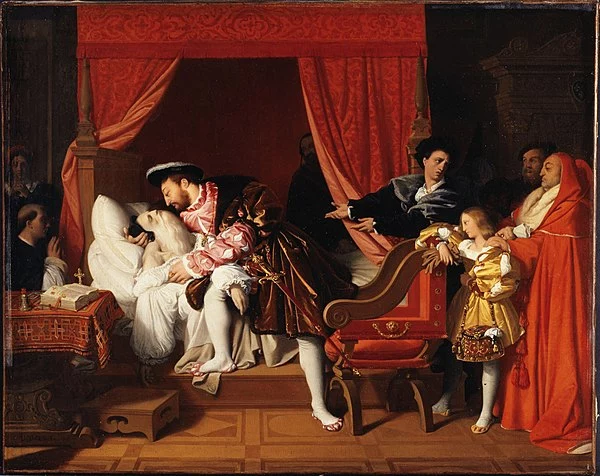
Obituary
His death caused the greatest sorrow to all who had known him. Never had painting been more honored by an artist. The radiance of his beautiful face cheered every sad mind, and his speech could move the most obstinate opinion to yes or no. He knew how to hold back every violent impetuosity by the power that dwelt in him. With his right hand he bent the iron of a wall ring or a horse's hoof as if they were lead. With natural generosity he offered hospitality to his friends, whether they were rich or poor, if only spirit and virtue graced them. The most insignificant, unadorned room he embellished and glorified by his every action. And as the city of Florence received a great gift by the birth of this artist, it suffered a more than bitter loss by his death. In the art of oil painting, a certain shading was invented by him, by which the newer artists give great strength and roundness to their figures. What he was capable of in sculpture he showed in the three bronze figures above the north door of San Giovanni. They were cast by Giovan Francesco Rustici, but designed according to Leonardo's specifications, and in drawing and execution are the most beautiful castings seen in recent times. To Leonardo we owe the anatomy of horses and the even more perfect one of the human body. And although he worked more by words than by deeds, for the sake of his many divine merits his name and reputation will never be extinguished.
Thus, in praise of him, Messer Giovan Batista Strozzi wrote the following:
He all alone defeated all others,
He triumphed over Phidias and Apelles
And their heroic band of epigones.
![[Translate to english:] [Translate to english:]](/fileadmin/_processed_/4/8/csm_giorgio-vasaris-biografie-ueber-leonardo-da-vinci_b61e953796.webp.pagespeed.ce.oFQA8ECw1H.webp)
![[Translate to english:] [Translate to english:]](/fileadmin/_processed_/8/b/csm_leonardo-alle-gemaelde_2dc4b01ef6.webp.pagespeed.ce.ohfmgl8OfF.webp)
![[Translate to english:] [Translate to english:]](/fileadmin/_processed_/c/e/csm_paolo-giovio_0acfba0bba.webp.pagespeed.ce.jz7fnLT_Al.webp)
![[Translate to english:] [Translate to english:]](/fileadmin/_processed_/4/9/csm_schwarz_cd1373893a.webp.pagespeed.ce.5WLx623R2V.webp)
